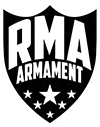Body Armor Ammunition Guide
If you’re not an industry insider, it can be difficult to figure out what kind of armor you need without a body armor ammunition guide. We get a lot of questions about our products that are vague and more broad than most folks understand. For example, one of the most common questions we get about virtually any product is, “will it stop 5.56?” That depends on what kind of 5.56 you’re talking about.
We can generally categorize ammunition into a few categories. Handgun ammunition and rifle ammunition are the two largest that most people think about. The five subcategories under each are:
- Full Metal Jacket
- Hollow Point
- Penetrator
- Armor Piercing
- Specialty (incendiary, tracer, explosive, etc.)
Manufacturers rarely test the specialty category since they are relatively rare and don’t exhibit substantial terminal performance against body armor unless they are combined with an armor-piercing slug. On occasion, we will test against these if we have a specific threat in mind, such as 7.62X39 API-BZ.
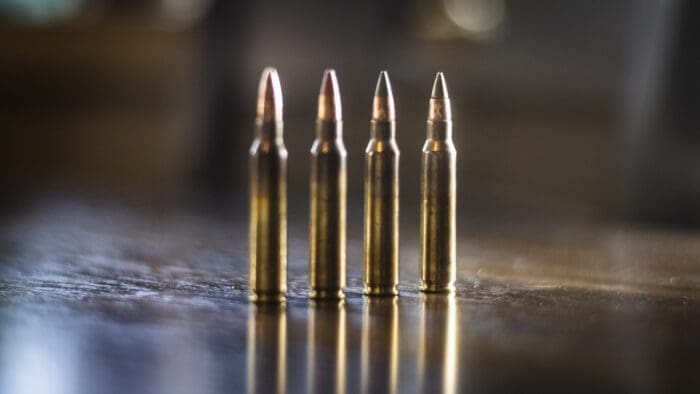
Full Metal Jacket Ammunition
FMJ rounds wrap a soft lead bullet in a copper jacket (or similar). Total Metal Jacket is identical to FMJ for our purposes today, as it makes virtually no terminal damage difference. Today, there are many solid copper rounds as well. However because copper is a relatively soft metal, it hasn’t proven to be much of an issue for most body armor. Older Aramid IIIA soft armor does occasionally have an issue with high velocity solid copper, but polyethylene does not. Given that UHMWPE is the majority of soft armor in use today, it simply isn’t really an issue.
Full metal jacket rounds are the lowest-cost option for range day use. Because they lack any special features for use against hard or soft targets, they’re not particularly ideal for defensive use. But due to their price, they’re great for target practice.
In recent years, FMJ ammunition has had the veneer of being a viable option for self-defense due to the widespread use of steel armor. Steel armor routinely fails against basic 5.56 FMJ–the single most common rifle round in the US. If you’re still wearing steel armor, now is the time to get something–anything better. If you’re not considering the total performance failure against the single most common rifle round in the United States, you should think about low-profile and lightweight handgun armor.
Hollow Point Ammunition
For some reason, people believe hollow points are more effective against body armor than FMJ rounds. Hollow points are actually less effective against armor than their FMJ counterparts, ceteris paribus. Hollow points are designed to rapidly expend their kinetic energy upon contact with their target. We’ll include similar ammunition in this category for our purposes such as soft point, polymer target point, and the like. The reason people use hollow point ammunition for defensive purposes is two-fold:
First, hollow point ammunition creates a more devastating terminal wound cavity than full metal jacket rounds. By expanding in diameter, hollow points cut, crush, and destroy a larger amount of their target by simply becoming larger. That larger diameter also allows the bullet to expend most to all of its kinetic energy into its target, creating the most devastating effect without wasting energy.
Second, energy that isn’t turned into damage on the target when shooting FMJ rounds is bad for two reasons. A round that over-penetrates isn’t being as effective as it could be against your intended target. It also endangers innocent bystanders by continuing beyond your target into whatever is behind it.
The inherent design of hollow point ammunition makes it ideal for use against non-armored soft targets–whether it’s for defensive or hunting use. By using hollow points, you are pre-supposing that your intended target won’t have body armor. When you’re up against armor, it’s just about the worst option you could have. Without a significant boost in velocity wildly beyond SAAMI spec (your gun will explode), a hollow point round of relatively equal mass and volume will offer sub-par performance against body armor compared to similar FMJ, penetrator, or AP munitions of equal caliber.
Body Armor Ammunition Guide: Penetrator Munitions
The penetrator category is where things tend to get a bit spicy in our body armor ammunition guide. Because there is so much variance in bullet design and velocity, there are a variety of penetrator rounds with extreme variances in ‘penetration’ capabilities. Technically, 7.62X39 mild steel core is a ‘penetrator’ round. However, it is slow enough that is is easily defeated by SRT and Level III plates without any ceramic needed.
Generally-speaking, the penetrator category is defined by any centerfire rifle round that has some kind of steel, tungsten, or other ‘harder’ metal component in the bullet. Because even mild steel is significantly harder and more resistant to deformation than soft lead, it is ideal for this category of ammunition. Sometimes called “light armor piercing,” penetrator rounds offer shooters the ability to effectively breach mild barriers such as walls, windows, and more without losing a significant amount of bullet mass, velocity, or terminal damage potential versus FMJ or hollow point munitions. Because of this capability, penetrator rounds do have the capability of penetrating certain kinds of armor.
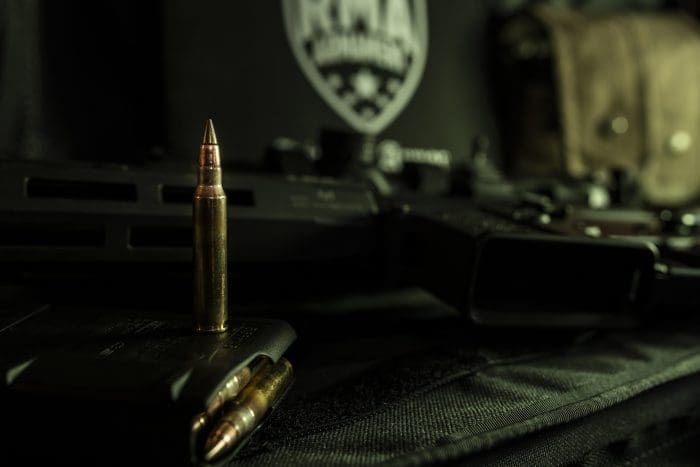
Penetrator rounds are rarely ideal for home defense or law enforcement use since criminal body armor use is very rare and they present a significant over-penetration danger to the public. However, it’s a good idea to have some on-hand just in case the need should arise. And in military use, it’s a smart solution for GIs that need a single round that can be deployed into most situations worldwide that has known hard and soft target performance.
The Green Tip
Certainly the best-known penetrator round is M855 5.56X45mm “green tip.” Green tip rounds have become widespread over the past twenty years due to production overruns during the Global War on Terrorism when it was the standard issue round for M16 and M4 rifles for the US military. Slower than most 5.56 at around 2700 fps, it does a decent job of penetrating some mild barriers and ultra-light 100% UHMWPE body armor. However due to its construction and velocity, it has relatively poor performance against soft targets. It’s the opposite idea of hollow points: anything that has stronger and more deformation-resistant properties has poor soft target performance. Designing a round to have strong soft target performance generally means it has poor armored target and barrier performance.
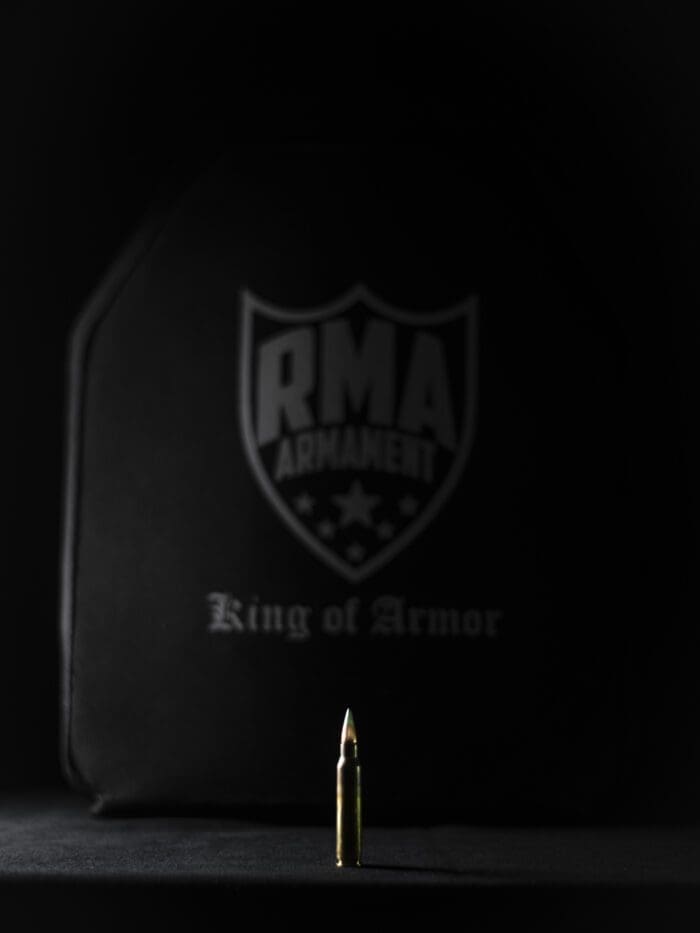
The Greener Tip
The Obama administration attempted to make an environmentally-friendly 5.56 munition to replace the lead and mild steel M855. Troops had complained for years about the poor efficacy of M855 green tip against non-armored hostiles, but this wasn’t the driving force behind the change. In the attempt to “green” the military’s footprint, they accidentally developed a round that has superior hard target and soft target capabilities across longer distances. Today, the M855A1 round is the standard-issue round for most of the US military. With either a mild tungsten or steel tip and a copper slug behind it, this lead-free penetrator round has started thrashing many Level III+ plates designed to defeat M855 green tip. Ammunition manufacturers only make M855A1 for the military. However, M855A1 is widely available in the civilian market. You should consider it a prevalent threat across the United States.
RMA got in front of this shift early, and released our Generation 2 RF2 plate designed to defeat the new M855A1 as well as the older M855 and subordinate threats such as FMJ and hollow point 5.56X45.
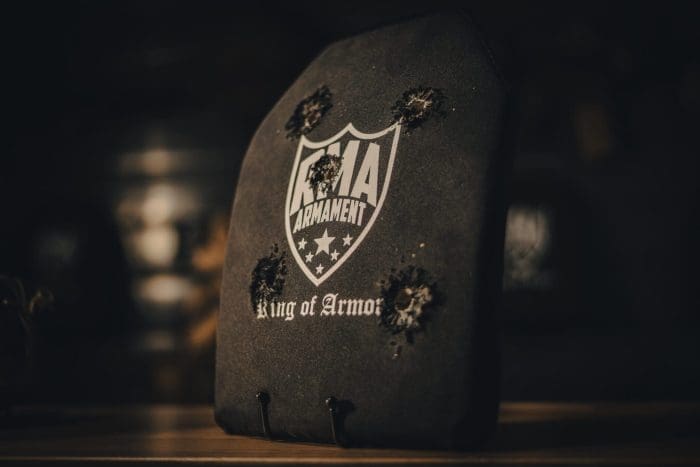
Steel Jacket
Manufacturers don’t make all penetrator rounds with a steel core or steel tip. Some rounds–like the 7.62X51 M80 NATO Steel Jacket–are made with a regular lead bullet wrapped in a steel jacket instead of copper. It’s technically a full metal jacket round. Except the jacket is made of steel. This isn’t the M80 you find at Cabela’s. And that’s important to know, because a lot of people don’t realize there’s a difference. M80 copper jacket doesn’t have nearly the penetration power of M80 Steel.
When we test a Level III or III+ plate, M80 Steel is the test standard, not M80 Copper. Unfortunately, many fly-by-night white label resellers of Chinese armor run quick tests without using the correct rounds. Many times, they use M80 Copper for their Level III tests either because they don’t know what they’re doing, or they’re hiding the poor performance of their plate against M80 Steel and they’re hoping you won’t know, either.
Level III Testing
The M80 Steel round is the current Level III test standard and the new RF1 standard (alongside M193). NIJ uses M80 Steel because it offers armor manufacturers and testing laboratories a strong worst-case-scenario round for FMJ bullet types. Generally-speaking, it penetrates far deeper than 5.56 M193, 308 Winchester, and similar 30 caliber and smaller FMJ threats thanks to its mass, velocity, and harder steel jacket.
When updating their testing standards, NIJ realized that steel armor was passing Level III testing when it shouldn’t have. NIJ’s assumption was that 5.56 FMJ was to be covered by M80 Steel testing under the Level III standard. With most ordinary armor materials like ceramic, aramid, and UHMWPE, it is. However, steel plates proved capable of defeating M80 Steel while utterly failing at 5.56 FMJ. Applied to the real world, you have armor that earns a Level III NIJ Certification while simultaneously failing the single most common rifle round in America. NIJ exists specifically for testing body armor efficacy for domestic US Law Enforcement. NIJ isn’t allowing steel to continue to pass this test against a virtually non-existent threat in M80 Steel (go ahead and try to find some) while it fails 5.56 M193, which can be found in every single gun shop in America.
Now, the new NIJ 07 RF1 test requires both 5.56 FMJ and M80 Steel testing to ensure steel plates can’t sneak by.
NIJ 07 RF2 Testing
The new RF2 Standard requires a plate to defeat all RF1 threats. Additionally, they must defeat M855 Green Tip, more M80 Steel, and 7.62X39 MSC in order to earn RF2 certification. RF2 is a baseline minimum for what used to be called Level III+. If you’re shopping for III+/RF2 plates, make sure you understand what you’re getting. RF2 is a minimum ballistic standard for penetrator-capable plates. Remember that M855 is not the king of the penetrator hill anymore. Most RF2 plates will not be able to defeat M855A1 unless they specifically list it as a threat. And M855A1 is available at gun shows and online at places like Gunbroker.
Armor-Piercing Ammunition
AP rounds are probably what most people come to our body armor ammunition guide to learn about. Armor-piercing ammunition has a lot of variance. In the US, we like to think of 30-06 M2AP as ‘the standard’ in AP performance. This is because NIJ uses M2AP as their Level 4 test standard. It does a decent job of covering many 30 caliber and smaller armor-piercing threats. That’s thanks to its combination of bullet hardness, mass, and velocity. However, even within M2AP there are several variants. Some foreign 30-06 M2AP bullet variants are more than twice as hard as US military specification M2AP. There’s no telling how many plates built to Level IV specification would be easily defeated by this variant.
AP ammunition comes in a variety of flavors. Today, hardened steel and tungsten comprise most AP bullets.
While Armor Piercing ammunition sounds scary, it’s to be more of a categorical material label. Some rounds are far more effective than others, and some are barely capable of penetrating armor at all.
What Kind of Armor?
7.62X39 AP is an example of a largely ineffective armor-piercing round. 7.62X39 API-BZ has the technical elements necessary to be an armor-piercing round, but its low velocity (2300-2400 FPS) means its can be easily defeated by a variety of SRT and Level III+ plates. Both our ESRT and 1090 Series plates easily defeat multiple impacts from 7.62X39 API-BZ. In fact, virtually all 7.62X39 variants are relatively easy for armor to defeat. These low-velocity rounds rank a step or two below their western counterparts. Many 5.56X45 AP variants are notoriously difficult even for many Level 4 plates to defeat due to their high velocity (2800 fps or better). 7.62X39 variants tend to land around 2300 FPS, which significantly reduces their kinetic energy transfer. In a sense, it’s less work for the plate materials to defeat.
Manufacturers make a variety of armor-piercing ammunition across a variety of cartridges. Not every Level 4 plate will defeat every armor-piercing cartridge. It’s important to understand that “armor-piercing” is not a universal label that should be applied to any kind of cartridge or armor. Instead, it’s useful to utilize it in reference to a particular munition.
Body Armor Ammunition Guide Conclusions
The big takeaway here is to understand how threat subordination works. We don’t posit out Body Armor Ammunition Guide as a universal checklist against our plates or anyone else’s. Instead, it’s to help you understand the fundamentals of how to choose the right plate for the job. We often think of Level 4 plates as the ‘easy button’ for body armor. And that’s a decent way of looking at it. Choose an American-made Level IV plate, and you’re protected from an enormous variety of threats without getting into the weeds with research. Each Level 4 plate will perform differently against a variety of threats, and there are plenty of munitions that can defeat a Level 4 plate. However, they’re very uncommon.
Remember that velocity, bullet construction, and multi-hit requirements play equal roles in determining the efficacy of a round against body armor. For example, we rate the 1155 against multiple impacts from 30-06 M2AP ammunition. A 300 Win Mag is higher velocity. Energy delivery may be higher, but a soft lead 300 Win Mag round doesn’t offer any more penetration capability over an armor-piercing 30-06.
Making assumptions about threat subordination and performance is exactly what made steel armor seem like a good deal. Sure, it defeats the Level III M80 Steel test. But it fails 5.56 M193–the single most common rifle round in America. Even NIJ’s assumptions about threat subordination didn’t pan out because not all materials perform identically.
Review lab reports and think critically about what exactly you are expecting your armor to do for you.
